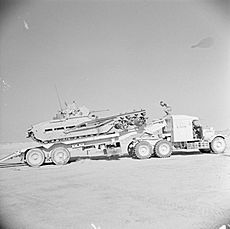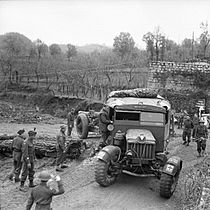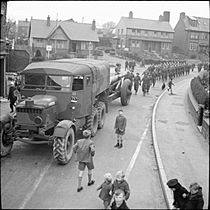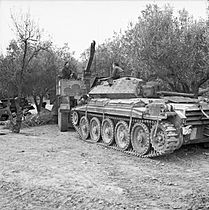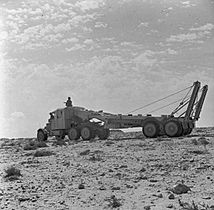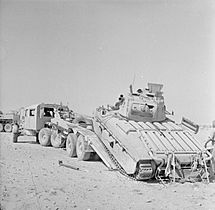Scammell Pioneer facts for kids
Quick facts for kids Scammell Pioneer |
|
|---|---|

A British Army Scammell Pioneer towing an 8-inch howitzer of 1st Heavy Regiment, near Calais (12 January 1940)
|
|
| Type | Tractor unit |
| Place of origin | United Kingdom |
| Service history | |
| In service | 1932 - 1980s |
| Used by | British Army |
| Wars | World War II |
| Production history | |
| Designer | Scammell |
| Designed | 1927 |
| Produced | 1927–1945 |
| No. built | 3,414 |
| Variants | Heavy artillery tractor, Heavy recovery vehicle & Tank transporter |
| Specifications | |
| Mass | Unladen: 8.38 long tons (8.51 t) Payload: 2.95 long tons (3.00 t) Max towed: 19.64 long tons (19.96 t) |
| Length | 20 feet 7 inches (6.27 m) Tank transporter: 22 feet (6.7 m), with trailer: 36 feet 6 inches (11.13 m) |
| Width | 8 feet 6 inches (2.59 m) Tank transporter: 9 feet 5 inches (2.87 m) |
| Height | 9 feet 9 inches (2.97 m) |
|
|
|
| Engine | 510 cu in (8.4 L) Gardner 6-cylinder Diesel 102 brake horsepower (76 kW) at 1700 rpm |
| Drive | 6x4 |
| Transmission | 6-speed constant-mesh gearbox |
| Suspension | Walking beam |
|
Operational
range |
430 miles (690 km) |
| Maximum speed | 24 miles per hour (39 km/h) |
The Scammell Pioneer was a powerful British truck. It was a 6x4 vehicle, meaning it had six wheels, with four of them powered. It was used in World War II for three main jobs: pulling big guns, rescuing broken-down vehicles, and carrying tanks.
Contents
How the Pioneer Was Made
The Scammell Pioneer was first built in 1927. It was designed as a tough, off-road vehicle. It was meant for places like British colonies where there weren't many paved roads.
Even though it didn't have power to all its wheels, it had amazing pulling power. This was thanks to its special suspension and a strong, slow-revving engine. It could move heavy loads on rough ground even at low speeds.
The British War Office bought one of these trucks in 1932. It was set up to carry tanks and was used for training. However, the army didn't buy more tank transporters until 1937.
Pioneer in Military Use
Most Pioneers bought by the British Army used a powerful 102 horsepower diesel engine. This engine drove the rear wheels and had a special part called a power take-off. This part allowed the truck to power a winch, which was very useful for pulling things.
Pioneer as an Artillery Tractor
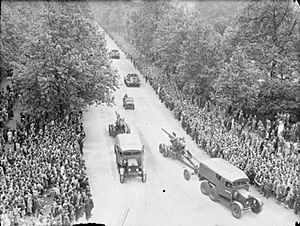
The Pioneer R100 was a heavy artillery tractor. It was introduced in 1935 and used throughout World War II. Its job was to pull medium and heavy artillery guns.
This version of the Pioneer had space for the gun's crew. It also carried their tools, equipment, and ammunition. It often towed guns like the 60-pounder and 6-inch howitzer. Later, it pulled even bigger guns like the 8-inch and 7.2-inch howitzers.
Many Pioneer gun tractors were lost in France in June 1940. This happened during the evacuation of the British Expeditionary Force. They were either destroyed by British troops or captured by the Germans.
By the end of the war, Scammell had built 980 Pioneer R100 artillery tractors. Because this wasn't enough, another type of heavy artillery tractor, the Albion CX22S, was also used from late 1943.
Pioneer as a Recovery Vehicle
Starting in 1936, the British Army began getting Pioneer heavy recovery vehicles. These trucks were designed to rescue other vehicles that were stuck or broken down. The first 43 were called Pioneer SV1S and Pioneer SV1T. They had a crane that could lift 3 tons and special storage for recovery tools.
Most of these early recovery Pioneers were also lost with the British Expeditionary Force in France.
The Pioneer SV2S was an improved version with a simpler, extending crane. This new crane could lift things even higher. It was introduced in 1938 and stayed in production throughout the war. A total of 1,975 SV2S models were built.
One cool feature of the Pioneer recovery vehicle was a pair of tracks. These tracks could be fitted over the two rear wheels. This temporarily turned the truck into a half-track, giving it much better grip on soft ground.
The last Pioneer recovery vehicle was used by the British Army until the 1980s in Belize. This shows how tough and useful these trucks were!
Pioneer as a Tank Transporter
The army started receiving special Pioneer tank transporters in 1937. This version had a longer cab to carry the tank crew as passengers. It also had larger rear wheels than the artillery tractor and recovery vehicle models. It was named Pioneer TRCU20.
There were two main types of tank transporters: 20-ton and 30-ton versions (Pioneer TRMU30/TRCU30). The trailer was mostly fixed to the truck, unlike modern semi-trailer trucks where the trailer can be easily detached. Tanks were driven onto the trailer using hinged ramps. If a tank couldn't move, the truck's winch could pull it onto the trailer.
The Pioneer tank transporters were quite tall. This meant they sometimes couldn't fit under some British bridges when carrying taller US tanks. Because of this, they were replaced by the American Diamond T tank transporter starting in 1941. However, the Pioneer tank transporter was still made throughout the war, with 459 units produced. After the war, the trailers were often scrapped because of their height, but the trucks were kept for other uses or sold to civilians.
Gallery
See also
- Mack NO 7½-ton 6x6 truck United States 6x6 heavy artillery tractor



